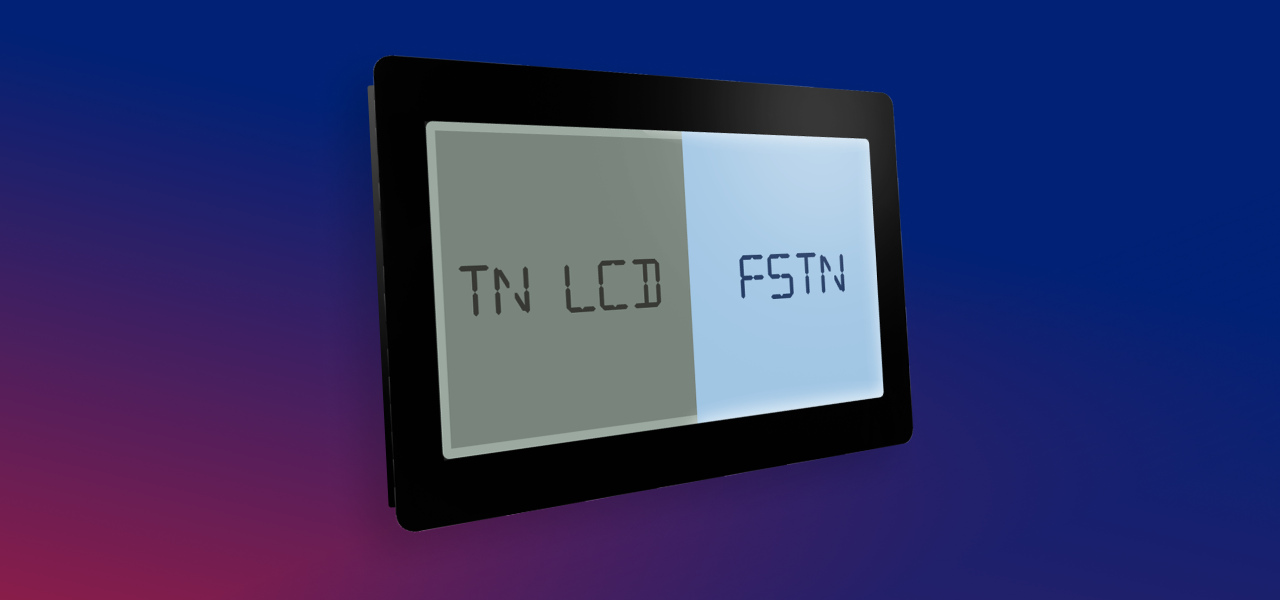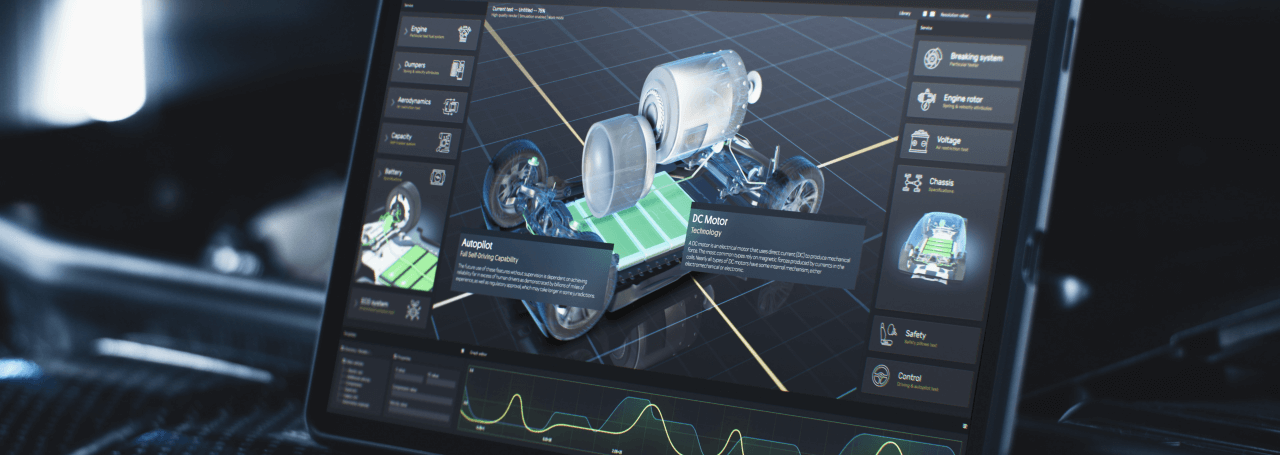Picture a calculator’s display struggling under bright office lights versus a medical device screen that stays clear in harsh illumination. This shows why engineers must understand the differences between TN and FSTN.
While both rely on twisted nematic liquid crystals, their optical behavior and performance make them fit for distinct use cases. Choosing incorrectly can mean the difference between a product that excels and one that frustrates clients with excessive power draw or undermines end users’ work due to poor visibility.
What are TN and FSTN
TN (Twisted Nematic) and FSTN (Film Super Twisted Nematic) represent two fundamental approaches to controlling liquid crystal orientation in display technology. Both technologies manipulate liquid crystals sandwiched between glass substrates with transparent ITO (Indium Tin Oxide) electrodes, but their molecular arrangements and optical behaviors differ significantly.
TN uses a 90° twist between polarizers; applying voltage untwists molecules to block light, creating ON/OFF states—the foundation of mass-market LCDs since the 1970s.
FSTN builds on STN (180–270° super twist) by adding a compensating film. STN’s higher twist improves contrast and reduces drive voltage versus TN, but introduces a yellow-green tint. The FSTN film corrects this tint and refines retardation, yielding sharper monochrome images with true black-and-white appearance.
TN LCD vs. FSTN at a glance
| Panel type | Response time | Color accuracy | Viewing angles |
| Twisted Nematic (TN) | 1ms | Mediocre | Poor |
| Film Super Twisted Nematic (FSTN) | 100-250ms | Very good | Wide |
TN LCD technology
Structure and advantages
TN’s simple stack keeps costs low and manufacturing efficient. The 90° twist enables very fast switching, valuable where quick refresh rates matter, from gaming monitors to responsive industrial panels. Standard drive voltages align with common microcontrollers usually requiring 3-5 V, and modest current draw of typically 20-50 milliamps suits many battery-powered devices. TN also tolerates wide operating temperatures from -20°C to +70°C with stable contrast and response, supporting reliable operation in varied environments.
Limitations and applications
TN technology’s key restricting factor is its narrow viewing angles: contrast drops quickly off-axis, and at extreme positions grayscale inversion can occur—dark areas appearing light and vice versa. This is most pronounced when viewed from below, so mounting orientation and typical viewing position should be planned early.
TN’s contrast is often adequate for text and simple graphics, but less ideal for subtle grayscale or smooth gradients without active-matrix control. Despite this, TN excels where speed, predictability of viewing direction, and cost are decisive—e.g., gaming displays, tightly positioned industrial HMIs, and automotive instrument panels with controlled sightlines.
FSTN LCD technology
Structure and advantages
FSTN addresses several TN shortcomings via a super-twisted alignment and a compensating film. The result is higher, more stable contrast and cleaner character edges in monochrome graphics. The film neutralizes STN’s color bias and manages optical retardation, enabling true black-on-white or crisp negative-mode—vital wherever color neutrality drives readability.
Beyond that, FSTN provides noticeably wider viewing angles than TN, maintaining usable contrast and character shape off-axis—important for panels read from varied positions.
Operating voltage requirements remain favorable: where TN commonly needs 5 V for optimal contrast, FSTN often meets or exceeds it at 3.3 V or less, aiding battery life and enabling more flexible driver designs thanks to a broader voltage tolerance.
Limitations and applications
The enhanced optical stack adds complexity that affects cost and response. Extra film and tighter tolerances raise pricing versus standard TN, and pixel transitions are slower, making FSTN unsuitable for rapidly changing content or video.
Temperature sensitivity also influences dynamics: while contrast remains strong across the rated range, response time varies more with cold, which can introduce visible ghosting effects during updates.
FSTN shines where readability under diverse lighting and angles outweighs speed: medical and lab devices, industrial instruments and measurement tools that demand clarity and stable contrast over long duty cycles.
Comparison of TN and FSTN
Technical differences
The core difference lies in twist angle and optical compensation. TN’s simpler 90° twist favors speed and cost but limits optical performance at wider viewing angles. FSTN’s super twist plus film compensation elevates contrast, color neutrality, and off-axis readability at the expense of complexity.
Viewing behavior is the standout divider: TN’s usable viewing region is comparatively narrow and prone to inversion in certain directions, whereas FSTN preserves readability across a broader range with less contrast or tone shift.
Power trade-offs are nuanced. While FSTN’s lower operating voltage suggests energy savings, the relationship proves complex. TN’s faster response time allows for lower refresh rates in static applications, potentially offsetting FSTN’s voltage advantage. Dynamic content reverses this equation, where FSTN’s slower transitions can actually reduce switching losses in frequently updated displays.
Performance and costs
Manufacturing economics favor TN in high-volume, cost-sensitive products thanks to a mature process and simplified materials, often yielding clearly lower unit prices for comparable sizes.
Performance priorities drive the choice: TN’s milisecond response of 60Hz or higher supports high refresh without ghosting for motion-rich UIs or rapid data changes. FSTN’s 5-10Hz practical refresh rate limit favors relatively static content where superior contrast, neutrality, and wider viewing are key, easing eyestrain across long shifts.
In professional markets, FSTN’s optical stability often justify higher initial cost: consistent readability as backlights age, predictable off-axis performance in shared workspaces, and durable legibility in demanding environments reduce lifetime service interruptions and total cost of ownership. Environmental testing shows FSTN maintaining acceptable contrast after 50,000 hours of operation, while budget TN displays might require replacement after 20,000-30,000 hours in similar conditions.
The contrast between TN and FSTN is not academic—it determines clarity, reliability, and efficiency in real use cases. For engineers, the choice goes beyond price: it’s about aligning optical behavior and long-term performance with the application’s demands.
Need expert guidance in matching display technology to your project?
Contact the Riverdi engineering team—we’ll help you identify the optimal solution and maximize performance for your specific application..
DISCOVER OUR
Whitepaper
Achieve the perfect user-display interaction with the right Touch Sensor IC. Ever faced issues with phantom touch events or certification? Boost your R&D like a pro with our Whitepaper!



